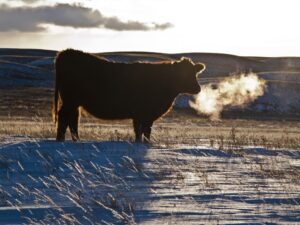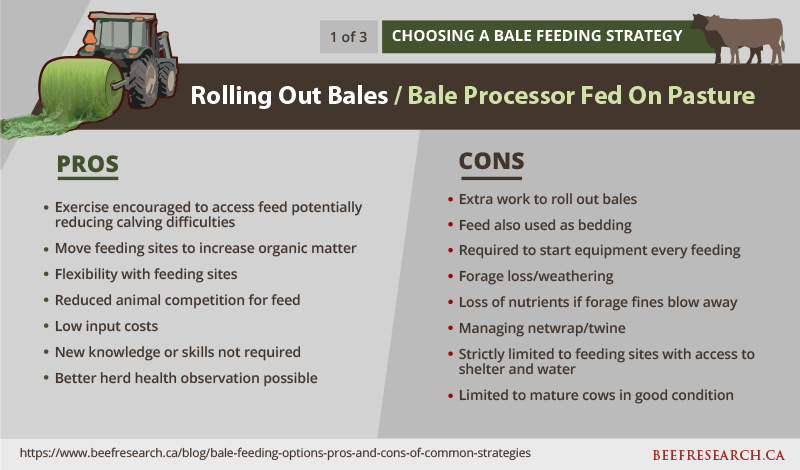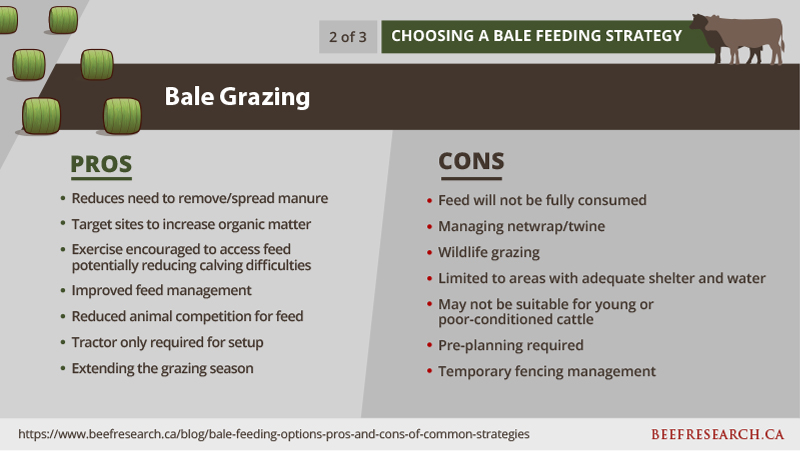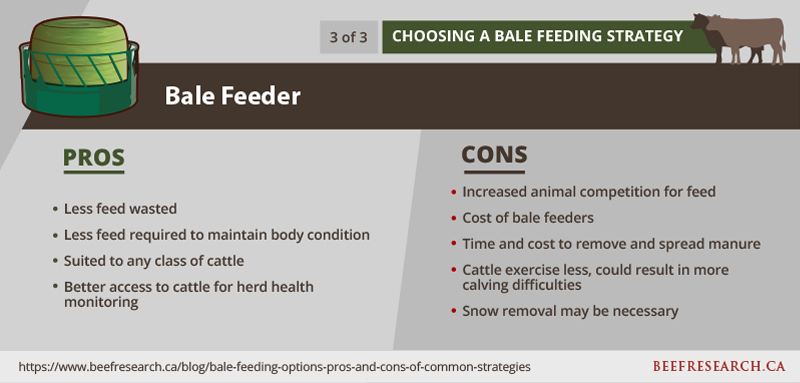Bale Feeding Options: Pros and Cons of Common Strategies
Bale feeding is common across Canada for all classes of cattle especially during winter months. There are many different management strategies to deliver bales as feed. To help you determine the best option for you and your cattle, see below for pros and cons of three common bale feeding strategies:
- Rolling out bales/using a bale processor and feeding on pasture
- Bale grazing
- Round feeder
When thinking about each strategy for your operation, consider the following: What are the nutritional requirements of your cattle? What is the nutritional quality of your forage? What equipment do you currently have? What equipment do you need? How much time do you have to dedicate to feed management?
Rolling out bales/bale processor fed on pasture
Pros
- Cattle are required to travel more for feed, encouraging exercise which may result in less calving difficulties
- Opportunity to move feeding location which allows manure to be deposited more evenly, reducing manure management costs, and targeting areas that would benefit from nutrient deposition
- Flexibility with feeding sites
- Reduced competition due to increased access to feed
- Low input cost. Equipment required is likely equipment already on farm
- Doesn’t require a lot of new knowledge or skills to implement
- Opportunity to monitor cow health before/during/after feeding as you are amongst the herd almost daily
Cons
- Extra work to roll out bales rather than having them free-standing or in a feeder
- Cattle will eat some high-quality feed and use the rest as bedding. While this provides organic matter to the soil, in years when feed availability is low and cost is high, it is a significant loss. (This loss can be remedied by portable bunks)
- Required to start equipment every feeding
- Winter conditions can cause forage loss/weathering
- Overprocessing (i.e. bale processor) can cause loss of nutrients if forage fines blow away
- Managing netwrap/twine is time consuming and can be difficult on equipment and cattle
- Site options are strictly limited to locations with proper shelter and stock water (or adequate snow cover)
- Limited to mature cows in good condition
Bale grazing
Pros
- Reduces or eliminates the need to remove/spread manure
- Can target sites to increase organic matter in areas that would most benefit in increased forage production
- Depending on size of grazing area, cattle may be required to travel more for feed, encouraging exercise which may result in less calving difficulties
- Feed testing is used to improve feed management
- More cattle can access feed at a time compared to rolling bales or using bale feeders
- Only requires a tractor once to set up fields, daily/weekly chores consist of moving fences
- Provides an opportunity to build a new skillset for feeding and managing cattle by extending the grazing season using bales
Cons
- Cattle won’t fully clean up feed. While this provides organic matter to the soil, in years when feed availability is low and cost is high, you want to minimize this loss
- Managing netwrap or twine needs to be a priority
- There may be losses due to wildlife grazing
- Sites strictly limited to areas with adequate shelter & water
- May not be suitable for young or poor-conditioned cattle
- Requires pre-planning to set up sites prior to winter feeding period
- Temporary-fencing management is required
Round feeder
Pros
- Cattle consume majority of the feed, leave less behind (“wasting” less)
- Lower cost than bale processing or rolling bales out due to reduced waste
- Less feed to maintain fat cover if hay has adequate nutrient density, as cattle are usually maximizing intake of what is fed
- Suited to any cattle class
- Easy access to cattle for monitoring or treating illnesses
Cons
- Cattle have limited access to feed based on available bunk space which can increase competition among animals
- Cost of bale feeders
- Required to start a feed truck/tractor for every feeding
- Increased time and financial cost to remove and spread manure if not moving feeding sites
- Cattle exercise less to consume feed, which can contribute to calving difficulties
- Snow removal may be necessary to support regular feeding activities
Additional Resources:
- Stored Forages (BCRC Web page)
- Feed Testing and Analysis for Beef Cattle (BCRC Calculator)
- Extending the Grazing Season (BCRC Blog Post)
- Bale Grazing Checks the Boxes for Three Canadian Producers (BCRC Blog Post)
- Eleven Ways to Avoid Feed Waste this Winter (BCRC Blog Post)
What did we miss?
Comment below.
Click here to subscribe to the BCRC Blog and receive email notifications when new content is posted.
The sharing or reprinting of BCRC Blog articles is welcome and encouraged. Please provide acknowledgement to the Beef Cattle Research Council, list the website address, www.BeefResearch.ca, and let us know you chose to share the article by emailing us at info@beefresearch.ca.
We welcome your questions, comments and suggestions. Contact us directly or generate public discussion by posting your thoughts below.



